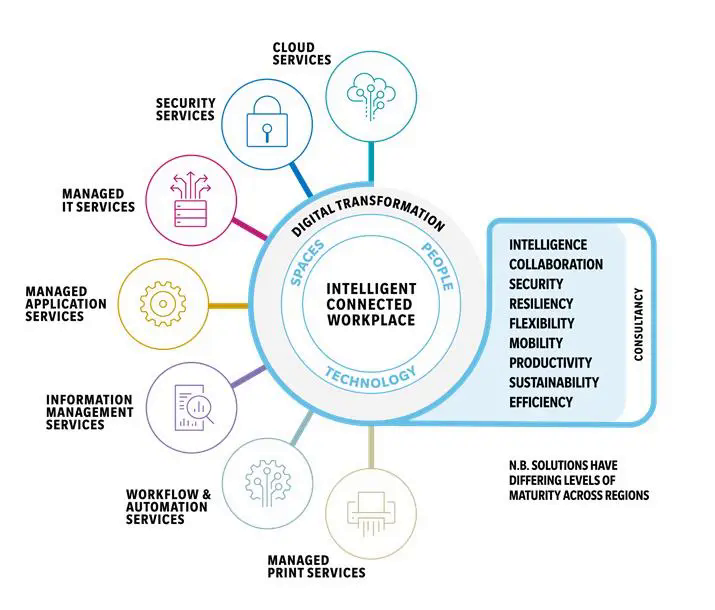Technology: the digital transformation toolbox
For small and medium-sized businesses in particular, the more complex IT requirements of digital transformation, such as building new infrastructure or scaling up existing systems, can be difficult to implement. These organizations generally don’t have the required experts in-house, so need to use external consultants to provide not only a whole range of products and solutions, but also full service and support. In the same way, a lot of larger organizations are being faced with documents locked in filing cabinets back at the office while trying to work remotely.
This is where managed service providers like Konica Minolta come in. We can provide you with a digital toolbox comprised of the tools and technologies your employees need to do their jobs, tailored to your industry. We see the ICW as being reached when you have competency in seven key areas:
- CLOUD SERVICES: Cloud computing technology underpins digital transformation, giving people the freedom and flexibility to work from any location without the need to run and maintain their own infrastructure.
- SECURITY SERVICES: Security supports and enables digitization, helping businesses to build their digital maturity from a secure
- MANAGED IT SERVICES: Ensures company systems are always up-to- date and secured, silently running in the background, whilst ensuring company data is never lost and eventually supporting business continuity and building digital maturity.
- MANAGED APPLICATION SERVICES: Provides companies with easy access to a range of different software and applications for businesses to implement transformational.
- WORKFLOW & AUTOMATION SERVICES: Simplified, yet powerful workflow processes allow businesses to work smarter, while customizable features and mobile capabilities provide flexibility and a user-friendly experience. Monitoring and tracking of workflows ensures processes are maintained and continue to run at high performance. Case Management solutions come in for organizations that have advanced beyond the early stages of digital transformation and are looking to get a 360-degree view of documents and data together.
- INTELLIGENT INFORMATION MANAGEMENT Converting the old paper to newly digitized content, this is designed to increase workflow efficiency, storage, security and compliance, by leveraging Intelligent Automation (IA) and Robotic Process Automation (RPA); routing digitized documents with automated workflows reducing turnaround and data entry.
- MANAGED PRINT SERVICES: Taking care of the entire print and scan infrastructure, combining consultancy services, hardware and software implementation, and workflow.
In most organizations, building your capabilities in these seven categories will support the ways in which you communicate, collaborate, connect and deliver your services. Too often, organizations implement these tools in silos without the benefit of a holistic digital transformation strategy. To remedy this issue, take the time to speak to our ICW experts, who can take the time to create a digital transformation strategy that clearly articulates your business focus and guides the development of your very own connected office.

The original article from our colleagues from the US you can find here.